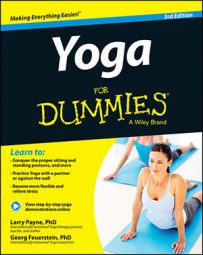As you travel through yogic postures, you begin to build awareness of the communications taking place between your body and mind. Do you feel peacefully removed from the raging storm of life around you, comfortable and confident with your strength, range of motion, flexibility, and steadiness? Or are you painfully noting the slow passage of time, sensing a physical awkwardness or strain in your movements?
Listen to your own feelings and sensations, and acknowledge their importance, to help make your Yoga experience an expression of peace, calm, and security. That positive message is what Yoga practice is all about.
Busting the perfect posture myth
Some modern schools of Hatha Yoga claim that they teach “perfect” postures that you can slip into as easily as a tailor-made suit. But how can the same posture be perfect for both a 15-year-old athlete and a 60-year-old retiree? Besides, these schools disagree among themselves about what constitutes a perfect posture. To spell it out, the perfect posture is a perfect myth.
As the great Yoga master Patanjali explained nearly 2,000 years ago, posture has only two requirements: A posture should be steady and easeful:
Steady posture: A steady posture is a posture that you hold stable for a certain period of time. The key isn’t freezing all movement. Your posture becomes steady when your mind is steady. As long as your thoughts run wild, your body also remains unsteady. As you become more skilled in self-observation, you become sensitive to the tension in your body. That tension is what Yoga means by unsteadiness.
Easeful posture: A posture is easeful when it’s enjoyable and enlivening rather than boring and burdensome. An easeful posture increases the principle of clarity — sattva — in you. But easefulness isn’t slouching. Sattva and joy are intimately connected. The more sattva is present in your body-mind, the more relaxed and happy you are.
Although Patanjali was thinking primarily, perhaps even exclusively, in terms of meditation postures, his formula applies to all postures equally.
Listening to your body
No one knows your body like you do. The more you practice Yoga, the better you become at determining your limitations, as well as your strengths, within each posture. Each posture presents its own unique challenges. You want to feel encouraged to explore and expand your physical and emotional boundaries without risking strain or injury to yourself.
Some teachers speak of practicing at the edge, the point at which the intensity of a posture challenges you but doesn’t cause you pain or unusual discomfort. The idea is to slowly and carefully push that edge further back and open up new territory. Cultivate self-observation and pay attention to the feedback from your body to be able to practice at the edge.
Each Yoga session is an exercise in self-observation without being judgmental. Listen to what your body is telling you. Train yourself to become aware of the signals that continually travel from your muscles, tendons, ligaments, bones, and skin to your brain.
Be in dialogue with your body instead of indulging in a mental monologue that excludes bodily awareness. Pay particular attention to signals coming from your neck, lower back, jaw muscles, abdomen, and any known problem or tension areas of your body.
To gauge the intensity of a difficult Yoga posture, use a scale from 1 to 10, with 10 being your threshold for tolerable pain. Imagine a flashing red light and an alarm bell going off after you pass level 8. Notice the signals and heed them, particularly your breath. If your breathing becomes labored, it usually indicates that you might want to back off.
Beginners commonly experience trembling when holding certain Yoga postures. Normally, the involuntary motion is noticeable in the legs or arms and is nothing to worry about, as long as you aren’t straining.
The tremors are simply a sign that your muscles are working in response to a new demand. Instead of focusing on the feeling that you’ve become a wobbly bowl of jelly, lengthen your breath a little, if you can, and allow your attention to go deeper within. If the trembling starts to go off the Richter scale, either ease up a little or end the posture altogether.
Moving slowly but surely
All postural movements are intended to be executed slowly. Unfortunately, most people are usually on automatic with movements that tend to be unconscious, too fast, and not particularly graceful. Most people are generally unaware of their bodies, but yogic postures lead you to adopt a different attitude. Consider the advantages of slow motion:
Enhanced awareness, which enables you to listen to what your body is telling you and to practice at the edge.
Safer practice. Slowing down lowers the risk of straining or spraining muscles, tearing ligaments, and overtaxing your heart.
Arrival at a deep stage of relaxation more quickly.
Improved breathing and breathing stamina.
Shared workload among more muscle groups.
For the best results, practice your postures at a slow, steady pace while calmly focusing on your breath and the postural movement. Resist the temptation to speed up; instead, savor each posture. Relax and be present here and now. If your breathing becomes labored or you begin to feel fatigued, rest until you’re ready to go on.
If you find yourself rushing through your program, pause and ask yourself, “Why the hurry?” If you’re truly short on time, shorten your program and focus on fewer postures.
If you’re rushing through your program because you’re feeling bored or generally distracted, pause and remind yourself why you’re practicing Yoga in the first place. Renew your motivation by telling yourself that you have plenty of time to complete your session. Boredom is a sign that you’re detached from your own bodily experience and aren’t living in the present moment. Participate fully in the process.

